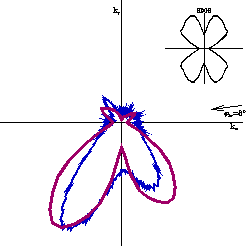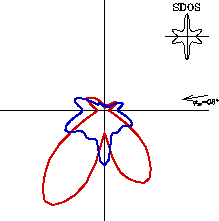|
Valence band photoemission spectroscopy usually detects the current for
emission angles and corresponding k-values on high symmetry lines of the
reciprocal space. On the other hand, photoelectron diffraction considers
the emission into the full hemisphere and therefore probes not only the
polar but also the azimuthal dependence. To take advantage of such
additional information and to proceed towards a common understanding of
both methods, azimuthal scans of the UV-photoemission from the GaAs(110)
surface are investigated. We compare results of a new theoretical determination
of the valence
band photoemission spectra with new experimental data.
 |
 |
Fig. 1: Photoemission intensities from GaAs(110) at an
initial energy of -0.75 eV from the calculation (violet) and of
-0.9 eV from the experiment (blue). The inset shows the surface
density of states for -0.75 eV.
|
Fig. 2: Theoretical currents for -0.75 eV (red) and for
-0.9 eV (blue). The inset shows the surface
density of states for -0.9 eV. |
Even this preliminary glance at the data allows to make some observations:
- There is an excellent agreement between experiment and
theory.
- The azimuthal scans show distinct topologies.
- The azimuthal pattern varies strongly with the binding energy.
Further investigations are needed to explain the angular distribution
of the photocurrent.
See also:
- Spatial origin of photoelectrons appears in
photoemission angular distributions
- C. Solterbeck, W. Schattke, J.-W. Zahlmann-Nowitzki, K.-U. Gawlik,
L. Kipp, M. Skibowski,
Azimuthal Dependence of GaAs(110) Ultraviolet
Photoemission Spectra, in "The Physics of Semiconductors",
ed. by M. Scheffler and R. Zimmermann, World Scientific,
Singapore 1996, Vol. 2, p. 835
- C. Solterbeck, W. Schattke, J.-W. Zahlmann-Nowitzki, K.-U. Gawlik, L. Kipp,
M. Skibowski,
Azimuthal Dependence of GaAs(110) Ultraviolet
Photoemission Spectra, Poster TuP-52 at the 23rd International
Conference on the Physics of Semiconductors, July 21 26, 1996,
Berlin, Germany
- W. Schattke,
Photoemission within and beyond the
one-step model,
Progr. Surf. Sci. 54, 211 (1997)
|


![]()
